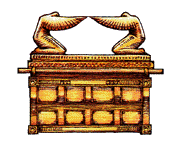The 'Ark' in Ethiopia
Graham Hancock is a
journalist, and at one time was East African
correspondent for the Economist. In 1983 he was in Ethiopia
working on a book about the country, commissioned by the
Communist government that came to power in 1974 when the
Emperor Haile Selassie was overthrown, and was itself
overthrown in May 1991. During his stay in Ethiopia he went
to Axum (or Aksum), the ancient capital of the kingdom of Ethiopia,
which in Roman times had been an important kingdom, and
which had adopted Christianity as its religion in the
fourth century A.D. Here he visited a walled compound, containing
two churches dedicated to 'Saint Mary of Zion', and the
ruins of a much older one, supposedly built in 372 A.D.
to house the ark of the covenant.
He discovered from his
Ethiopian guide that the ark had supposedly remained
there ever since, apart from a hundred-year period of
turbulence when it had been removed for safekeeping. It
was currently said to be housed in a new chapel, built by
Haile Selassie. In 1989 Hancock decided to investigate
the story, and his 600-page book is partly the results of
his historical research and partly a travelogue of his journeyings
in investigating the story.
The book ends with an
account of a further visit to Axum in January 1991, in
time for a feast of the Ethiopian Church known as Timkat,3
at which the supposed ark of the covenant is paraded
before the populace in a ceremonial procession. Here he
met a monk called Gebra Makail, the guardian of the ark
of the covenant, and the man portrayed, and so sensationally
described, on the dust jacket of the book. Makail refused
either to let him see the ark or even to describe it to him.
He then witnessed the procession, at which a large rectangular
chest, covered with a blue cloth with a dove embroidered
on it, was carried at the head of the procession. He
concluded, however, that this was not the ark, but a
replica, because the guardian of the ark remained at the
door of the chapel where it was kept, not even troubling
to look at it as it departed. He ends his book, however,
firmly committed to the belief that the chapel in
Ethiopia really houses the original ark. Whether or not
one accepts this, his story is an interesting one because
of the information he unearthed about aspects of the history
of the Jewish people.
Next section: Ethiopia and the Jews

